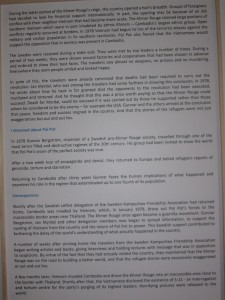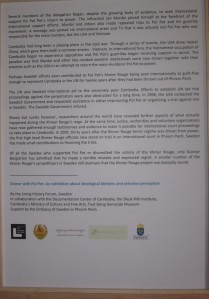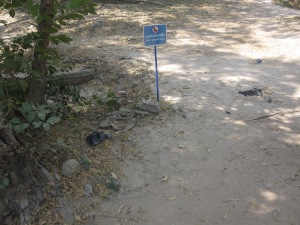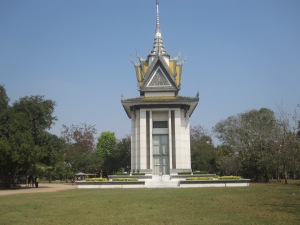
En av byggnaderna vid S-21 och framför byggnaden syns några av tortyrmetoderna. One of the buildings of S-21. Some of the torture methods are seen in front of the builiding.
Efter lunchen åkte vi till fånglägret/fängelset S-21 (Tuol Sleng museum), som fått sitt namn efter att vaktchefen hade walkie-talkie nummer 21. Innan röda khemererna tog över Kambodja så var dessa byggnader en skola, men vid kommunisternas övertagande så blev klassrummmen tortyrkammare och fånghålor. Precis som Nazisterna, så var kommunisterna mycket noga med att dokumentera varje fånge. Varje individ som kom till S-21 fotograferades och mättes och nogranna anteckningar gjordes från alla förhör. Fångarna blev tvingade genom olika utstuderade tortyrmetoder att erkänna att de var CIA eller KGB agent eller motarbetade kommunismen och domen blev alltid avrättning vid Choeung Ek (dödens fält) efter att all information uttömts.
I ett av rummen fanns en utställning som handlade om Sveriges vänster-rörelses anmärkningsvärda förhållande till Pol Pot regimen. Sverige var det enda landet som tilläts besöka Kambodja och röda khmererna. En av våra stora frågor som dök upp hos oss efter besöket vid dödens fält var varför Pol Pot sågs som den officiella ledaren av Kambodja i världssamfundets ögon och fick representera Kambodja i FN hela tolv år efter det att kommunisterna störtats av Vietnam. En stor anledning till detta verkar vara Sveriges (bl.a. Jan Myrdal och Gunnar Bergströms) aktiva stöd till Pol Pot (personen som slaktat ⅕ av sin egen befolkning) och det i sin tur har lett till att rättegångarna mot de ledande kommunisterna inte kunde börja förrän 2006, åtta år efter att Pol Pot dog (efter att ha levat fritt fram till 1 år innan hans död) och 30 år efter början på folkmordet.
Även fast den svenska delegationen fick se tillrättalagda platser och människor som hade tvingats att sätta upp sitt bästa leende så hade Jan Myrdal starka misstankar att oppositionella måste ha mördats, men Jan såg det som att målet helgade medlen för att kunna nå den kommunistiska drömmen (härlig kille!).

Nu och då porträtt av medlem ur röda khmer armén! Now and then portrait on a former member of the Khmer Rouge army!
Det var även intervjuer med personer som frivilligt eller ofrivilligt anslutit sig till röda khmerernas armé. Många fotografier av de som suttit i S-21 (och senare mördats) finns utställda på muséet och även många förhörsprotokoll som innehåller deras livshistoria, anhöriga och vad de tvingades erkänna finns att läsa. När Phnom Penh befriades 1979 av den vietnamesiska armén så var endast sju vuxna och fem barn levande kvar i fängelset. Historier från några av dessa överlevande fanns också att läsa här.
After lunch we went to the detention center/prison S-21 (Tuol Sleng Museum), named after the prison officer who had walkie-talkie number 21. Before the red khemers took power in Cambodia these buildings were a school, but after the communist takeover these class rooms became torture chambers and prison cells. Just like the Nazis, the communists meticulously documented each prisoner. Every individual who came to S-21 was photographed and measured and lengthy files were kept from all interviews. The prisoners were forced to admit through various elaborate torture methods that they were CIA/KGB agents or opposed to the communist party and the judgement was always execution at Choeung Ek (Killing Fields) after all the information was extracted.
In one of the rooms there was an exhibition about the Swedish left-movements remarkable relation to the Pol Pot regime. Sweden was the only country that was allowed to visit Cambodia and the Khmer Rouge. One of our big questions that popped up with us after the visit to the killing fields was why Pol Pot was seen as the official leader of Cambodia in the international community’s eyes and represented Cambodia at the UN twelve years after the communists were overthrown by the Vietnam military. A major reason for this seems to be Sweden’s (Jan Myrdal and Gunnar Bergström’s) active support to Pol Pot (the person who slaughtered ⅕ of the Cambodian population), and this in turn can explain why the trials of the leading Communists could not begin until 2006, eight years after Pol Pot died (after having lived freely until one year before his death), and 30 years after the start of the genocide.
Even though the Swedish delegation was shown highly glorified places and people who had been forced to put up their best smile, Jan Myrdal had strong suspicions that the opposition must have been murdered, but Jan saw it as a prize worth paying to reach the communist dream (lovely guy!).
There were also interviews with individuals who voluntarily or involuntarily joined the Khmer Rouge army. Many photographs of those who sat in the S-21 (and later murdered) are exhibited in the museum and also their interrogation reports containing their life story, family members and what they had to admit under torture. When Phnom Penh was liberated in 1979 by the Vietnamese army, there were only seven adults and five children who were left alive in the prison. Stories by some of these survivors was also available in the museum.
Bildtext nedan: Svenska vänsterrörelsens inblandning och stödjande av Pol Pot! The Swedish left movement’s involvement and support for Pol Pot!








